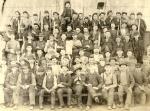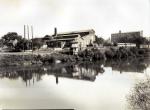![header=[Marker Text] body=[Built in 1752 by John Potts, ironmaster and founder of Pottstown. The manor was located at the center of a 1,000 acre plantation that included the town, an iron forge, gristmills, and other businesses by 1762. The town was incorporated 1815 as the borough of Pottstown] sign](http://explorepahistory.com/kora/files/1/10/1-A-2B3-139-ExplorePAHistory-a0k1z3-a_450.jpg)
Mouse over for marker text
Name:
Pottsgrove Manor
Region:
Philadelphia and its Countryside/Lehigh Valley
County:
Montgomery
Marker Location:
At site, 100 W. King St., Pottstown
Dedication Date:
September 25, 2000
Behind the Marker
Thomas Potts and his son, John Potts, created the largest iron-making empire in colonial America. By 1750 John Potts became, in his own right, the foremost ironmaster in Pennsylvania. Both Thomas and John Potts built this empire on their knowledge of iron-making, sound business decisions, and especially the contributions of relatives.
During the eighteenth century and well into the nineteenth century, ironmasters relied on partnerships with relatives, previous business associates, and trusted friends. Trust was a critical component of such partnerships, since iron furnaces and forges required substantial investments and partners were personally liable for any debts should a furnace or forge fail, which they frequently did. Among Pennsylvania ironmasters, Thomas and John Potts were incomparable at developing their iron holdings through kinship networks.
Thomas Potts started his family's empire by becoming manager of the first blast furnace in Pennsylvania, Colebrookdale Furnace located on Iron Stone Creek in the Schuylkill River valley.
Colebrookdale Furnace located on Iron Stone Creek in the Schuylkill River valley.  Thomas Rutter and other partners from Philadelphia established Colebrookdale Furnace about 1720. In 1725 Thomas Potts leased the furnace and became its resident manager, living near Thomas Rutter's family. While leasing this furnace, he earned enough money to buy a two-thirds share in the furnace and a one-third share in Pine Forge, also owned by Colebrookdale Furnace partners. He was able to buy these shares in part because of the deaths of Thomas Rutter and all three of Rutter's sons who inherited shares. Thomas Potts also cemented his ties to the Rutter family as his three sons each married a granddaughter of Thomas Rutter. His son John formed yet another close tie to Colebrookdale Furnace; in 1734 he became a founder there.
Thomas Rutter and other partners from Philadelphia established Colebrookdale Furnace about 1720. In 1725 Thomas Potts leased the furnace and became its resident manager, living near Thomas Rutter's family. While leasing this furnace, he earned enough money to buy a two-thirds share in the furnace and a one-third share in Pine Forge, also owned by Colebrookdale Furnace partners. He was able to buy these shares in part because of the deaths of Thomas Rutter and all three of Rutter's sons who inherited shares. Thomas Potts also cemented his ties to the Rutter family as his three sons each married a granddaughter of Thomas Rutter. His son John formed yet another close tie to Colebrookdale Furnace; in 1734 he became a founder there.
John Potts built upon his experience at Colebrookdale Furnace, and on his widespread family network. Above all, he capitalized on his marriage in 1734 to Ruth Savage, oldest of the Rutter granddaughters. Ruth Savage was the daughter of Anna Rutter Savage Nutt, one of the principal heirs of ironworks previously established by Thomas Rutter, Samuel Nutt, and Samuel Savage, all of whom were early Pennsylvania ironmasters. It was through his mother-in-law that John Potts expanded his iron holdings. Anna Nutt helped erect Warwick Furnace, one of the largest iron furnaces in colonial Pennsylvania.In 1745 she gave her half interest in Warwick Furnace to John and Ruth Potts.
Warwick Furnace, one of the largest iron furnaces in colonial Pennsylvania.In 1745 she gave her half interest in Warwick Furnace to John and Ruth Potts.
John Potts built his empire around the productive Warwick Furnace, using that furnace to supply pig iron other refinery forges and using its profits to buy or build forges for himself. During the 1740s and 1750s he acquired or increased his interests in Pine Forge, Mount Joy Forge (also called Valley Forge), and Coventry Forge, all located in the Schuylkill River valley. He erected a mansion at Mount Joy Forge, which George Washington later used as his headquarters during the Continental army's winter encampment at Valley Forge in 1777-1778.
In 1752 he established the iron plantation of Pottsgrove, where he built a mansion house and refinery forge and laid out a village in a grid pattern. He made Pottsgrove his family seat and the residential and commercial center for the forge. Warwick Furnace produced pig iron that supplied all these and other refinery forges in southeastern Pennsylvania.
John Potts was shrewd in acquiring forges that provided almost guaranteed markets for Warwick Furnace iron, much as owners of Greenwood Furnace did a century later. But he also had to find markets for products made at his forges. Like other eighteenth-century ironmasters, he sold his forge products mostly in the local market. In doing so, Potts again relied on relatives. He turned first to his brother-in-law Thomas Yorke, a Philadelphia merchant, to sell forge products. Then he relied on his three oldest sons to help market iron and also manage his iron works. In addition, when two more sons became Philadelphia merchants, he had two more relatives to help sell his iron and also buy supplies for his iron plantations. Potts's extensive family connections were not only critical to his acquiring furnaces and forges; they were also essential to his marketing.
Greenwood Furnace did a century later. But he also had to find markets for products made at his forges. Like other eighteenth-century ironmasters, he sold his forge products mostly in the local market. In doing so, Potts again relied on relatives. He turned first to his brother-in-law Thomas Yorke, a Philadelphia merchant, to sell forge products. Then he relied on his three oldest sons to help market iron and also manage his iron works. In addition, when two more sons became Philadelphia merchants, he had two more relatives to help sell his iron and also buy supplies for his iron plantations. Potts's extensive family connections were not only critical to his acquiring furnaces and forges; they were also essential to his marketing.
John Potts died in 1768, after willing his empire to his children. The Potts family's wealth and prominence never again reached the heights that John Potts had achieved. The Potts family encountered disruptions during the American Revolution, including the British destruction of Valley Forge, and downswings in iron prices in the last decades of the century. They also faced growing competition from other iron furnaces and forges established in southeastern Pennsylvania.
The family also became a hindrance to prosperity. As ownership became fragmented among the children, each son worked on his own holding or passed management to others. The result was Potts family furnaces and forges that came to compete with each other. Gone was the strong, central control that John Potts had exercised over the family empire.
During the eighteenth century and well into the nineteenth century, ironmasters relied on partnerships with relatives, previous business associates, and trusted friends. Trust was a critical component of such partnerships, since iron furnaces and forges required substantial investments and partners were personally liable for any debts should a furnace or forge fail, which they frequently did. Among Pennsylvania ironmasters, Thomas and John Potts were incomparable at developing their iron holdings through kinship networks.
Thomas Potts started his family's empire by becoming manager of the first blast furnace in Pennsylvania,
John Potts built upon his experience at Colebrookdale Furnace, and on his widespread family network. Above all, he capitalized on his marriage in 1734 to Ruth Savage, oldest of the Rutter granddaughters. Ruth Savage was the daughter of Anna Rutter Savage Nutt, one of the principal heirs of ironworks previously established by Thomas Rutter, Samuel Nutt, and Samuel Savage, all of whom were early Pennsylvania ironmasters. It was through his mother-in-law that John Potts expanded his iron holdings. Anna Nutt helped erect
John Potts built his empire around the productive Warwick Furnace, using that furnace to supply pig iron other refinery forges and using its profits to buy or build forges for himself. During the 1740s and 1750s he acquired or increased his interests in Pine Forge, Mount Joy Forge (also called Valley Forge), and Coventry Forge, all located in the Schuylkill River valley. He erected a mansion at Mount Joy Forge, which George Washington later used as his headquarters during the Continental army's winter encampment at Valley Forge in 1777-1778.
In 1752 he established the iron plantation of Pottsgrove, where he built a mansion house and refinery forge and laid out a village in a grid pattern. He made Pottsgrove his family seat and the residential and commercial center for the forge. Warwick Furnace produced pig iron that supplied all these and other refinery forges in southeastern Pennsylvania.
John Potts was shrewd in acquiring forges that provided almost guaranteed markets for Warwick Furnace iron, much as owners of
John Potts died in 1768, after willing his empire to his children. The Potts family's wealth and prominence never again reached the heights that John Potts had achieved. The Potts family encountered disruptions during the American Revolution, including the British destruction of Valley Forge, and downswings in iron prices in the last decades of the century. They also faced growing competition from other iron furnaces and forges established in southeastern Pennsylvania.
The family also became a hindrance to prosperity. As ownership became fragmented among the children, each son worked on his own holding or passed management to others. The result was Potts family furnaces and forges that came to compete with each other. Gone was the strong, central control that John Potts had exercised over the family empire.







